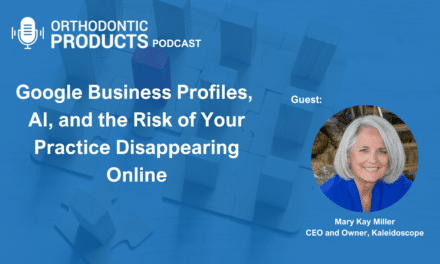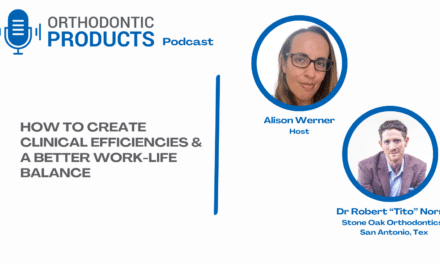In this episode of the Orthodontic Products podcast, Leon Klempner, DDS, CEO of People + Practice, shares strategies for managing mid-career orthodontic transitions, from bringing on associates to opening new locations or rebranding. Effective communication, patient-focused messaging, and digital updates are key to capitalizing on these milestones while preserving trust.
Key Takeaways:
- Clear communication and rebranding are essential when adding an associate or partner.
- Buying a retiring doctor’s practice requires trust-building strategies and digital updates.
In this episode of the Orthodontic Products podcast, host Alison Werner continues her conversation with Leon Klempner, DDS, CEO of People + Practice, to explore the critical marketing strategies for orthodontic practices navigating mid-career transitions. These pivotal milestones—such as adding an associate, purchasing a retiring doctor’s practice, or opening a second location—require thoughtful planning to maximize growth opportunities while mitigating risks.
Bringing on an Associate: Building Trust and Confidence
When bringing on an associate, Dr. Klempner emphasizes the importance of clear and proactive communication. Miscommunication or lack of transparency can lead to confusion among patients, staff, and referring doctors. Ensuring a well-orchestrated introduction of the associate is essential for maintaining trust. The messaging should highlight the associate’s credentials and the benefits they bring to the practice, such as expanded hours or additional services. This approach reassures patients while fostering confidence in the transition.
Acquiring a Retiring Doctor’s Practice: Preserving Goodwill
For practices acquiring a retiring doctor’s practice, preserving the goodwill built over the years is paramount. The handoff requires a joint effort to ensure continuity of care. Dr. Klempner stresses the importance of co-creating communication materials with the retiring doctor to assure patients that their care remains in trusted hands. Updates to digital assets, such as websites and social media profiles, should reflect the transition seamlessly while maintaining ties to the legacy of the outgoing doctor.
Opening a New Office: Establishing a Local Presence
Opening a new office represents another significant opportunity for orthodontic practices to expand their footprint. This milestone requires a strong marketing strategy tailored to the new community. Dr. Klempner highlights the importance of establishing a Google Business profile, engaging in local events, and showcasing the practice’s unique value proposition to attract attention and establish credibility in the new area.
Rebranding: Reflecting Growth and Evolution
For practices seeking to rebrand, whether due to growth or evolving goals, Dr. Klempner advises starting with a clear definition of the practice’s value proposition. Rebranding should reflect the unique offerings of the practice, resonate with the community, and ensure consistency across all marketing platforms, including websites, logos, and social media.
This episode underscores the importance of leveraging these mid-career transitions as opportunities to strengthen the practice’s reputation, grow its patient base, and enhance its presence in the community.
Tune in for the next episode, where the 3-part series concludes with strategies for orthodontic practitioners preparing for retirement or selling their practice.
Podcast Transcript
Alison Werner (00:11)
So in this episode, we’re gonna take a look at how your marketing strategy needs to respond to those big career transitions and milestones from bringing on an associate or a partner or opening even a new office. We’ll look at how to prepare your practice for a smooth transition, including communication strategies to maintain patient trust. Dr. Klempner, thank you for joining me again.
Leon Klempner (00:32)
Well, happy to be back.
Alison Werner (00:33)
All right, so let’s start this. Are there specific considerations you take into account when you’re talking with a practice that’s well established?
Leon Klempner (00:43)
Well, there are. And as I said in the last episode, there are still these basic areas that we need to start from, which is we need to plan for common mid-career transitions and milestones. We also need to capitalize. Our goal is to capitalize on those opportunities to help grow the practice. That’s typically the reason for the transition. But at the same time, we also
Alison Werner (01:10)
Right.
Leon Klempner (01:13)
need to be aware of some of the risk factors and to evaluate a strategy to help us reduce those risks.
Alison Werner (01:22)
So as you mentioned, and as I mentioned in my intro, one of those common milestones of that mid-career ortho includes bringing on an associate. So what are the considerations you take in that case?
Leon Klempner (01:37)
So for sure, bringing on an associate is probably the most common of those milestones. But as you mentioned, there are others as well. whether you’re bringing an associate in as an associate as the end game or as a partner as the end game, that could change the strategy as well, as well as opening a new office or
purchasing somebody else’s office. where would you like to begin?
Alison Werner (02:11)
Well, let’s start with that associate. Because you talked in the last episode about you were working with an oral surgeon who you refer to patient to as a long-standing relationship. And then the patient gets over there and it’s a new doctor. It’s a new, I’m guessing it was an associate. And that you were a little taken off guard by that and not having been introduced. And so the patient’s the one who’s telling you. So let’s talk about bringing on a new associate and avoiding that kind of problem for your referring doctors too.
Leon Klempner (02:27)
Mm-hmm.
You know, a lot has to do with looping in the referring doctors for sure in the communication process. So as I said before, there needs to be an organized way of…
rolling out the new associate to all of the different stakeholders and it needs to be done in order. You don’t want your referring doctors to be the second person to know. You don’t want them hearing from their patients that, I saw some new guy instead of the one that you referred me to. That’s never a good practice builder. So we want to try to minimize the disruption that can occur when bringing someone in.
So you can imagine bringing in a new doctor, and I’ve gone through this process so can tell you from experience, that when you bring in a new doctor, there are a lot of misconceptions that go on. know, patients are concerned. You know, is the old doctor, old meaning established doctor, you know, is he leaving? You know, is there going to be like a bait and switch here? Wait a minute, I thought I was getting this guy and now I’m getting this guy.
Alison Werner (03:32)
Okay.
Right.
Right.
Yeah.
Leon Klempner (03:54)
You know, having patient schedule with the typically younger associate is sometimes challenging unless you establish some credibility there. So that nobody wants to make an appointment. That’s something that we need to mitigate as well. So what’s important is communicating to your patients and your team and your staff and referring doctors and the community.
Alison Werner (04:07)
Right.
Mm-hmm.
Leon Klempner (04:22)
How you pick this individual. What is special about them? Why did I choose this one? What do they bring to the table? And when you think about it, what patients really are looking for when you drill it all down is what’s in it for me.
You know, how does this affect me? That’s what they’re concerned about. So you want to build in as much benefit to the patient as possible in the communication. Some examples might be, you know, and now we can now have extended after school appointments.
Alison Werner (05:00)
Mmm, yep.
Leon Klempner (05:01)
something that’s a pain point for most. Or now we’re open Saturdays, whereas we weren’t before. So how you communicate it what you communicate in is so important when bringing in an associate. And the order, as I said, is also critical as well.
Alison Werner (05:06)
Right? Right.
Leon Klempner (05:23)
Sometimes though, when you’re bringing in a partner versus an associate, well, that sometimes would necessitate a brand change. know, use me as an example, you know, for a long time my practice was Leon Klempner, DDS orthodontist. So for 20 years I built this brand that was based on Leon Klempner. People would know Leon Klempner as the name.
Alison Werner (05:34)
Okay.
Leon Klempner (05:52)
Leon Klempner, referring docs would refer to Leon Klempner. So now you bring in a potential partner, well you have to establish that credibility and if the brand, if the name of the practice is Leon Klempner Orthodontics, that’s not gonna work in the long term. So when you have a partner, now you have to think about a rebrand. You know something more,
Alison Werner (05:53)
Yep.
Okay.
Leon Klempner (06:19)
genetic that doesn’t include the senior doctor’s name so that, you know, you could build that brand. So a lot of, you know, interesting things that are important to pay attention to.
Alison Werner (06:33)
Yeah, definitely. so before we kind of talk about the marketing strategies for each of these transitions, let’s talk about the last one that you mentioned earlier and that transition that you mentioned earlier. And that is taking over another orthodontist practice who is retiring as a second location. How does that or even opening a new office, how does that differ from bringing on that new doctor?
Leon Klempner (06:57)
Well I mean when you’re when you’re purchasing an existing practice you’re again paying much for the goodwill of that particular practice. It’s important that those patients that that are coming into your practice now are transferred over and the trust is transferred over so that they’ll bring their siblings so that the practice will continue. So again.
Alison Werner (07:02)
Mm-hmm.
Leon Klempner (07:27)
The handoff is so important in terms of the communication. You know, why I’m selling to this particular doctor. you can’t let the seller off the hook here if you’re the buyer. It’s in your best interest to have that seller transfer that trust over.
Alison Werner (07:35)
you
Ha.
Leon Klempner (07:46)
jointly communicate why in a letter. Have everybody understand why and how it’s done. It’s almost like a handoff in football or passing the baton in a relay race. You want to emphasize how the retiring doctor is working hand in hand for a smooth transition. Again, what’s in it for me is what the patients are thinking about. Okay, how’s he gonna know what’s the next
Alison Werner (07:51)
Mm-hmm.
Right.
Leon Klempner (08:16)
step or what we’ve been talking about or the treatment plan. Am I going to be now starting all over again? We need to mitigate all of those fears and concerns. And that could be done with effective communication, but it needs to be done in an orderly, thought-out process.
Alison Werner (08:20)
Yeah.
Leon Klempner (08:38)
And that’s the critical area there. And again, this oftentimes, know, purchasing a practice now, it has a different name. You’re going to have to, you know, think about a brand change and similar to a new practice.
Alison Werner (08:41)
Yeah. Okay. Yeah.
Right.
Leon Klempner (08:55)
When you’re opening a second location, similar marketing strategies, making sure your digital assets are in place, your Google profile, your location, so that Google knows that you have another location.
Alison Werner (09:10)
So let’s talk about kind of the marketing perspective, the process there. So let’s start with a new doctor. So whether that be an associate or partner. imagine there’s little differences, because you did talk before about how there are differences in your strategy to create that trust. What should those?
What should those doctors be doing in terms of their marketing?
Leon Klempner (09:33)
Well, whenever our team encounters these transitional scenarios, we always take a step back to reestablish the differentiated value, the value proposition of the practice, between the two doctors. Because sometimes that changes. So the next step is to incorporate that differentiator.
and look at the website, does it reflect that? Is it consistent? Because things change. If it’s an associate, you need to add a bio page. You need to highlight their photograph.
So you need to make some changes on your digital properties on the website and on social so that they’re also involved. So it’s important that you know in either scenario when you’re dealing with these types of transitions you want to plan for both the internal and the external marketing. That means you have to think about your current patients, your referring doctors, the staff as well as attracting new patients.
So for the first group, you want to keep confidence in the practice, reduce high anxieties, for example. And then the latter, you want to focus on brand awareness of the doctor or the location. And this can be done with advertising, digital advertising, or building reviews.
Alison Werner (11:00)
Okay, and then let’s talk about the buying a retiring doctor’s practice. What are some of your recommendations there on the marketing side?
Leon Klempner (11:11)
Well I mean you know it’s similar in terms of the goal is we want to grow the practice. So you know we want to transfer the trust over. We want to make sure that all of our digital properties are reflecting the new practice. We want to highlight in our communication how this benefits their current patients. So you know and then we want to go back and make sure that the website.
the Facebook ads, the traffic ads, the Google paid ads. Everything is reflective of the new practice. It’s an opportunity.
You know, we look at these events and these milestones as opportunities. This is an opportunity to showcase your practice to the community. That’s way we look at it. So you need to capitalize on it. They don’t happen that often in your practice where something changes. It’s not like you bought a new scanner and okay, you you’d say, look, you know, at some point that was, yeah, you know, at some point that was a big deal, no more.
Alison Werner (12:04)
Right.
Yeah. It’s hard to market that too externally. Right.
Leon Klempner (12:18)
Goopy impressions, that type of thing. not anymore. you know, not everybody has a scanner. you know, not everybody brings on an associate, brings on, opens up another practice. You know, these are ways of highlighting your differentiator and your footprint in the community. And we want to mitigate all of the negatives as well with good communications as well.
Alison Werner (12:21)
Yeah. Yeah.
You mentioned making sure your website’s on point and your social media. If you’re buying a practice, that practice probably had its own website, probably had its own social media channels. What should you do with those old digital properties?
Leon Klempner (12:57)
Well that’s a really good question and that depends on the individual case. You know there are instances where there’s quite a distance between the two communities and.
And in those cases, if they’re well established, then we don’t want to disrupt things too much. So we might want to do some branding and keep another website. You don’t necessarily need to consolidate. But in more instances than not, it’s easier to just fold it in and transfer as much of the juice to the main practice. But it really varies from practice to practice on an individual basis. The other thing is the marketing.
Alison Werner (13:15)
Mm-hmm.
Okay.
Leon Klempner (13:40)
The different communities have different styles.
Alison Werner (13:43)
Yeah.
Leon Klempner (13:43)
And as marketers, we don’t often talk about this, but we have clients that are in the very rural areas of the Midwest, and we have clients in LA and in Manhattan. And the marketing has to be different. It has to reflect the personality of the location that you’re dealing with. And so many times we see that not paid attention to and it backfires. So being very sensitive
Alison Werner (13:56)
Mm-hmm.
Yeah.
Leon Klempner (14:14)
to the community that you’re dealing with. And I know orthodontists, this has come up many times where they wanna make sure that it’s not too showy depending on their personality. So we have to work within the personality of the orthodontist as well as the personality, so to speak, of the community so that we find that fine line that drives new patients in but doesn’t ruffle any feathers, doesn’t…
Alison Werner (14:26)
Yeah.
Yeah.
Leon Klempner (14:43)
you know, denigrate their competitors or anything like that.
Alison Werner (14:46)
Mm hmm. Yeah. OK, so the last transition we want to talk about is that opening that new practice, that satellite, that new office. And like you said, like that’s a big moment for a practice. It’s an opportunity to get in front of the community in a new way, because it’s not just getting a scanner anymore, which I’m sorry is not big news, like you said. So what should they be doing? What?
What should they be doing in terms of marketing and what does this moment lend itself to?
Leon Klempner (15:17)
Well, it’s an opportunity now to address the highlights and the differentiators of the practice. So if we’ve gone through the process.
of establishing a value proposition that is deliverable, that the community wants, that their competitors are not advertising at least, even if they are doing it, they’re not promoting it. Well, that’s our lane. That’s our opportunity. you know, any of the transitions give us that opportunity to go out and express that. The other thing is, you know, everything isn’t
Alison Werner (15:37)
you
Leon Klempner (16:00)
all digital. You you can’t delegate certain things to an external marketing company. As much as you’d like, I’m speaking to the orthodontist out there, as much as you’d like to say, okay, I’m going to pay you, you do everything and I’m done, it doesn’t work that way. It’s got to be a partnership and you still have to pay attention to the community and to the dentists. You know,
Alison Werner (16:02)
Yeah.
Leon Klempner (16:30)
All too often, orthodontists are writing off their general dentists because they’re doing aligners, they’re competitors, I don’t know. There’s a laundry list of things that annoy orthodontists about referring dentists. However,
Alison Werner (16:36)
Yeah.
Yeah. Yes. Yes. Yes.
Leon Klempner (16:49)
They refer and you know they they’re important to the lifeline of the practice. We want to get our new patients particularly in this environment. This is very competitive environment we’re in right now. You know practices are some practices are struggling and it’s important that we reach all of put all our tentacles out. We want them from all directions including the general dentists. We want to be in the community. We want to support the local schools. We want to be at the.
Alison Werner (17:01)
Yeah.
Yeah.
Leon Klempner (17:19)
local fairs, we still want to be doing all of those things. And if dropping off bagels counts and works in your area, then you do those bagel runs. But you know, the connection with the general dentist is still very important. And I remember in my own practice, I used to, I had a list and a spreadsheet and I have my top 10 referrers on the spreadsheet. And
Alison Werner (17:31)
here.
Mm-hmm. Yeah.
Leon Klempner (17:47)
Once a month, I would make a point of making sure I made contact with each one of those.
And maybe it was a patient that I saw that day. What? Great opportunity. Hey, I saw Johnny. I’m a little concerned about his hygiene. I talked to mom that maybe it might be good idea for them to come in and see you, or maybe your hygienist could work with them. I hate to see him get marks on his teeth. I’d really appreciate it. That’s a contact. That’s not only a contact, but that’s showing the dentist that you care about them.
Alison Werner (17:55)
Mm-hmm. Yeah.
Mm-hmm. All right. Yeah.
Leon Klempner (18:20)
And invariably, even if the doc wasn’t referring a lot of patients, after a call from that a couple days later, I’d get a referral. It counts. It counts. So we need to make a conscious effort to maintain those relationships as well.
Alison Werner (18:29)
yeah. Yeah. Yeah.
Yeah, you want to be top of mind. yeah. Yeah.
Leon Klempner (18:40)
You want to be top of mind. That’s exactly it. And it’s you know it’s it’s competitive right now and getting more and more competitive. The truth of the matter is Alison and I hate to say it but it from being in this this is our 13th year. So we have I have a pretty good pulse on what’s going on in the in the orthodontic field and we get a lot of data. We you know we’re we we have the Gaidge data of our patients so I see all of the numbers.
Alison Werner (18:58)
Yeah.
Leon Klempner (19:10)
The sad reality is that you can no longer be a plain vanilla orthodontist. You can’t be just put your shingle out and open your office and expect to do well in this environment. Everybody is marketing up.
Everybody is understanding that that it’s competitive and they need to carve out their share in the community or their practice will be on the decline. So you know all the things that we’ve been talking about all serve in that direction. But the transitions really give us that opportunity to to highlight things that oftentimes might go under the radar.
Alison Werner (19:56)
Speaking of kind of those transitions allowing you to highlight things that might have been going under the radar, what about for a practice who is kind of that mid career point and doesn’t like their brand or doesn’t feel like it’s serving them anymore? They’re tired of it. They’ve outgrown it or just doesn’t fit anymore. And what would your advice be to them if they’re at that mid career point? And maybe they do have a transition. Maybe they don’t. You do. Okay.
Leon Klempner (20:21)
Yeah, we get a lot of that. We get a lot of that. And the reason we get a lot of it is because a lot of practices have gone flat.
You know, then up until now they felt that they didn’t really need it. It was something that wasn’t that important. They already have a website that they created, you know, years ago and they have a logo that, you know, they picked out of a book somewhere and, you know, they felt, I’ve got it covered. I’ve got it covered. I’ve tried Facebook and, you know, I have an assistant that is good on Facebook. So she’s, she’s tried that. It doesn’t work, you know.
Alison Werner (20:48)
Right. Mm-hmm.
Yeah.
Leon Klempner (21:00)
And basically they come to us out of necessity and they’re willing to listen at that point. And to answer your question, we start from the beginning. What is, we go through the differentiation exercise. Let’s talk about it. What is it in your community that the patients want? What is it that you can consistently deliver upon? What is it that your competition is not doing?
Alison Werner (21:04)
Mm.
Okay.
Leon Klempner (21:28)
And then we just develop a branding document. then, from that, we develop a meaningful logo and a website that’s built for SEO and conversion from the bottom up. And Google Ads, Facebook Ads follow, reviews follow.
Alison Werner (21:50)
Yeah.
Leon Klempner (21:53)
So we have a program basically that covers all of these things and they need to be covered. If you don’t cover them, for example, if you don’t pay attention to your reviews, then everything you’re doing to build your brand gets sabotaged because digital natives look at reviews.
Alison Werner (21:59)
Yeah.
you.
Leon Klempner (22:11)
They look at reviews for restaurants. They look at reviews for orthodontists as well. And if your competitors have 100 or 200 and you have three or four or 10 or 20, it’s not enough. And we all know those reviews are a game more than anything else. They don’t necessarily reflect the ones with the best reviews or the best orthodontists. That doesn’t work that way. But you’ve to play the game. So we have a system of
Alison Werner (22:11)
Yep. Yep.
Mm-hmm.
Yep, absolutely. Yep.
Right. Yes. Yeah. Yep.
Leon Klempner (22:38)
building reviews. So we need to mitigate the possible negative reviews. That’s the other thing. If you don’t have a lot of positive reviews, you get a negative review, hurts. If you have a lot of positive reviews, you get one negative review, people write that off as well. That’s just a one-off type of thing. So consistency and covering all of the bases. And we like to talk about a holistic approach. That’s what we talk about.
Alison Werner (22:44)
Alright.
Dr. Klempner, thank you so much for all your insight and we’ll have you back for our next episode where we’re gonna talk about that transitioning out phase, that end of career and handing your practice off to someone else or closing up. Thank you. All right, excellent. All right, thank you.
Leon Klempner (23:18)
Okay, I’ve been there too, so I’m looking forward to it.













